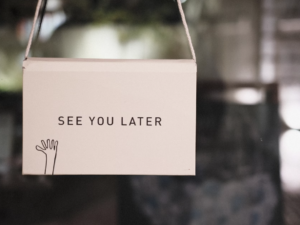Most audiences these days include at least a couple of bowed heads, would-be listeners who are checking “emails” (aka social media), waiting for you to stop talking so they can scroll in peace. Here are ways presentation experts and seasoned pros avoid killing softly with PowerPoint.
1. One message per slide.
Just going to leave this here.
2. Use large text.
A 30-point font is suggested by the inimitable Guy Kawasaki, whose 10-20-30 rule has proven a popular framework for presentations.
3. Stick to your topic
By all means, digress, but be careful not to derail your presentation.
Pro tip: Hitting the “b” key will cause the screen to go blank mid-presentation, which is handy if you want to follow a discussion that gets sparked.
4. Take your time without stealing theirs.
Don’t plow through your presentation at warp speed, but don’t lollygag, either.
5. Use no more than five objects per slide.
Studies show the brain will explode otherwise. (It’s science.)
6. Have a Plan B.
Be ready for last-minute schedule changes, surprise attendees, or to wing it without technology (gasp).
7. Limit animations, GIFs or other distracting elements.
It’s too easy for these to look sophomoric, so use sparingly.
8. Project.
Have a commanding presence with good posture and appropriate volume.
9. Prepare.
You don’t have to memorize the entire deck, but your audience will know if you’re unfamiliar with it.
10. Test equipment.
Get there early enough to set up and test all equipment, if possible.
11. Provide context if giving technical info or hard data.
Demonstrate how such information could affect your client’s bottom line, perhaps exemplifying with one of their competitors.
12. Highlight important details.
You may need to be ruthless here and hand-pick survivors.
13. Limit word count.
See what I did there? Aim for the 1-6-6 rule:
- One idea per slide
- Six bullets per idea
- Six words per bullet
14. If, however, you have more words per slide than can fit on a Post-it, create two decks: one to present, one to leave behind.
You can still deliver all the details without overwhelming your presentation.
15. Use a sans-serif font.
Let the content class it up, not a hard-to-read font.
16. Restrict your color palette to 5 colors, max.
Leave the rainbow to Skittles. Two to three brand colors (theirs or ours) are always a safe bet.
17. Round up or down if the exact amount isn’t critical.
Your message still comes across and can be less cluttered.
18. Use high-quality images only.
Don’t let a grainy photo compromise the overall aesthetic of your presentation.
19. Use a dark background with light text.
This combo is much easier on the eyes and adds a touch of drama.
20. Practice.
Rehearse anywhere – in the shower, during commercial breaks, or even on your commute (if it’s safe).
Now go knock ’em dead – just not with PowerPoint.
Sources for this article:
- Louis Richardson, Chief Storyteller at Synti Data Quality, “Corporate Storyteller” workshop, STORY Conference, September 18, 2019.
- Choosing Colors for Your Presentation Slides (Think Outside The Slide)
- Best Practices for PowerPoint Presentations (MIT Alumni)
- Top Ten Slide Tips (Garr Reynolds)
- The 10/20/30 Rule of PowerPoint (Guy Kawasaki)






